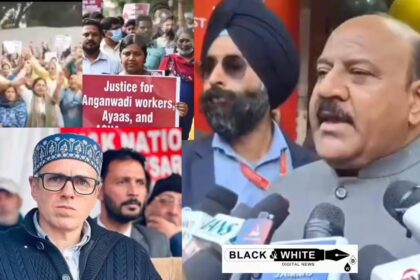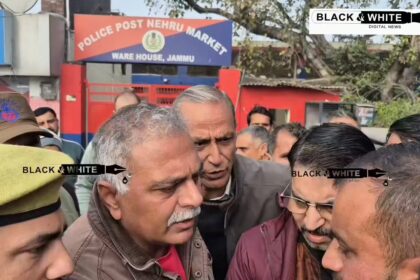Government of India has announced the annual observance of June 25 as ‘Samvidhaan Hatya Diwas’.
||Black and White Digital News ||
||Parvinder Singh July 13 ,2024 ||
Context and Significance
On June 25, 1975, then-Prime Minister Indira Gandhi imposed a nationwide Emergency, a period marked by severe curtailments on civil liberties, mass incarcerations, and media censorship. This 21-month period is often remembered as one of the darkest chapters in Indian democracy, reflecting the authoritarian tendencies that suppressed dissent and silenced opposition.
In a move to commemorate the resilience and struggle of those who opposed the Emergency, the Government of India has announced the annual observance of June 25 as ‘Samvidhaan Hatya Diwas’ (Constitution Murder Day). This decision, led by Prime Minister Narendra Modi, aims to honor the sacrifices of millions who fought to restore democratic norms and personal freedoms during this turbulent period.
The Decision and Its Implications:
Prime Minister Modi’s government has underscored the importance of remembering the Emergency to prevent any recurrence of such draconian measures. By designating June 25 as ‘Samvidhaan Hatya Diwas,’ the government seeks to instill a collective memory of the past abuses and to reinforce the values of democracy and freedom.
The 1975 Emergency: A Brief Overview
Imposition:Indira Gandhi declared the Emergency citing internal disturbances. This move followed a controversial court verdict that invalidated her 1971 election due to electoral malpractices.
Repression:During the Emergency, over 100,000 political opponents, activists, and journalists were arrested. Civil liberties were suspended, and a strict censorship regime was enforced on the press.
Impact:The Emergency period saw the curtailment of personal freedoms, forced sterilizations, and demolition drives that displaced thousands. The judiciary was also pressured to support the government’s actions, undermining the independence of the judiciary.
Commemorating the Struggle:
‘Samvidhaan Hatya Diwas’ will serve as a day of remembrance for the countless individuals who endured persecution and fought for the restoration of democracy. The observance of this day is also a reminder of the importance of safeguarding democratic institutions and principles against any form of authoritarianism.
Statement from Prime Minister Modi:
Prime Minister Narendra Modi, while announcing the observance of ‘Samvidhaan Hatya Diwas,’ emphasized the need to honor those who stood up against tyranny. He stated, “The struggle of millions during the Emergency era symbolizes the indomitable spirit of democracy. By commemorating this day, we ensure that the sacrifices made are never forgotten and that the lessons of history guide our future.”
The declaration of ‘Samvidhaan Hatya Diwas’ is a significant step towards acknowledging and honoring the resilience of those who resisted the Emergency’s oppressive regime. It serves as a powerful reminder of the value of democratic freedoms and the need to remain vigilant against any threats to these fundamental rights.
————‐——————– ——————————-
Understanding the 1975 Emergency: Reasons Behind Indira Gandhi’s Decision.
Why Indira Gandhi Imposed the 1975 Emergency: A Detailed Analysis of the Four Key Reasons
On June 25, 1975, India witnessed an unprecedented political upheaval as Prime Minister Indira Gandhi declared a state of Emergency. This period, lasting until March 21, 1977, saw the suspension of civil liberties, mass arrests, and strict media censorship. The declaration of Emergency is often attributed to four main reasons, each of which played a crucial role in shaping this controversial decision.
Judicial Setback: The Allahabad High Court Verdict.
One of the most immediate triggers for the Emergency was the Allahabad High Court’s ruling on June 12, 1975, which found Prime Minister Indira Gandhi guilty of electoral malpractices during the 1971 Lok Sabha elections. Justice Jagmohanlal Sinha convicted her on charges of using government machinery for her election campaign and invalidated her election. The court’s decision also barred her from holding any elected office for six years. Facing the prospect of losing her position as Prime Minister, Gandhi viewed the Emergency as a means to maintain her grip on power.
Political Unrest and Opposition Movements:
The period leading up to the Emergency was marked by widespread political unrest. The most notable among these movements was led by Jayaprakash Narayan (JP), who called for a “total revolution” against corruption and misgovernance. JP’s movement gained significant momentum, with massive rallies and strikes challenging the authority of the government. The growing popularity of these opposition movements threatened the stability of Gandhi’s administration, prompting her to declare the Emergency to stifle dissent.
Economic Challenges and Social Unrest:
India in the mid-1970s faced severe economic challenges, including high inflation, unemployment, and food shortages. The economic downturn led to widespread social unrest, with strikes and protests becoming common. The government struggled to address these issues effectively, and the discontent among the populace continued to grow. The declaration of Emergency was seen as a way to curb the increasing unrest and impose strict control over the population to restore order.
Internal Security Concerns:
The government justified the Emergency on the grounds of internal security threats. Indira Gandhi and her advisors argued that the nation was facing a significant threat from internal disturbances and conspiracies aimed at destabilizing the government. They cited the possibility of insurgencies, secessionist movements, and political conspiracies as reasons necessitating the imposition of Emergency. This narrative of internal threats was used to legitimize the suspension of democratic processes and civil liberties.
Impacts of the Emergency:
Suspension of Civil Liberties: Fundamental rights were suspended, and censorship was imposed on the press. Political opponents, activists, and journalists were arrested without trial.
Mass Arrests:Over 100,000 people, including opposition leaders, activists, and dissenters, were detained under preventive detention laws.
Censorship:The media faced stringent censorship, with newspapers requiring government approval before publication.
Forced Sterilization Campaigns:The government launched aggressive population control measures, leading to forced sterilizations, particularly targeting poor communities.
Judicial Manipulation:The independence of the judiciary was undermined, with the government exerting pressure on the judiciary to support its actions.
The imposition of the 1975 Emergency by Indira Gandhi was a culmination of judicial setbacks, political unrest, economic challenges, and perceived internal security threats. Each of these factors contributed to her decision to declare Emergency, leading to a period of authoritarian rule that has left a lasting impact on Indian democracy. The annual observance of ‘Samvidhaan Hatya Diwas’ serves as a reminder of the importance of safeguarding democratic values and preventing the recurrence of such dark chapters in history.
Leave a comment
You Might Also Like
J&K Government Approves 18% Increase in Public Transport Fares from January 2026
J&K Government Approves 18% Increase in Public Transport Fares from January 2026 #JKGovt #PublicTransport #FareHike #TransportFareHike #JammuAndKashmir #JKNews #SrinagarNews #PublicTransportUpdate…
0 Min Read
Hum Daily Wagers Ko Phase Wise Permanent Karege Sunil Sharma Sahab Jawab De Rattle Power Project K Logon Ko Kam Kyu Nahi Krne De Rahe Hai Deputy CM Surinder choudhary
Hum Daily Wagers Ko Phase Wise Permanent Karege Sunil Sharma Sahab Jawab De Rattle Power Project K Logon Ko Kam…
0 Min Read
Warehouse Jammu Me Police Aur Labour Issue Ko Deepak Gupta Ne Hal Karwa Diya
Warehouse Jammu Me Police Aur Labour Issue Ko Deepak Gupta Ne Hal Karwa Diya #DeepakGupta #JammuWarehouse #PoliceAurLabourIssue #IssueResolved #ProblemSolved #JammuNews…
0 Min Read
My Tarigami Protest In Jammu Favour Of Daily Wagers Asha Workers
My Tarigami Protest In Jammu Favour Of Daily Wagers Asha Workers
0 Min Read








